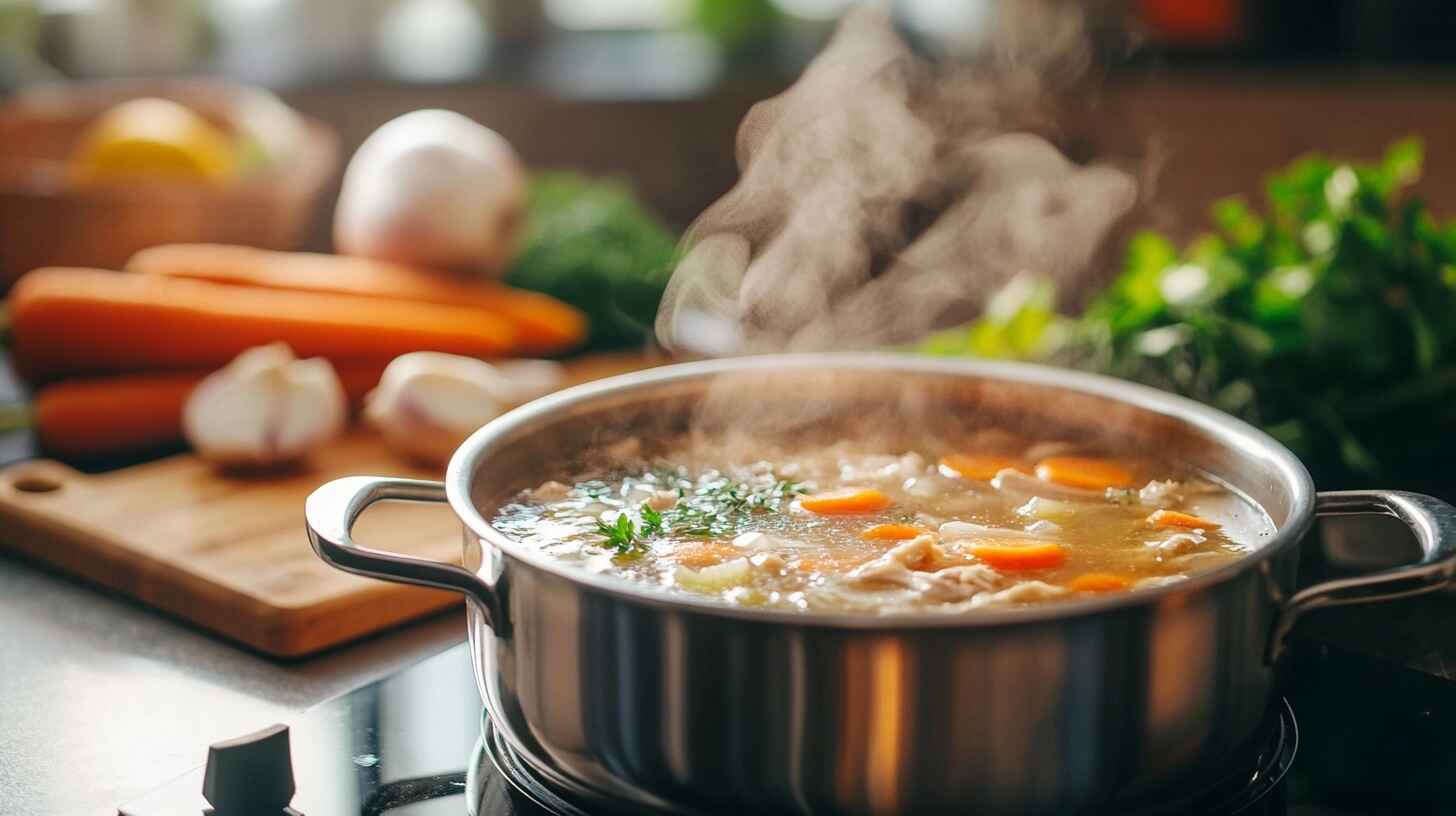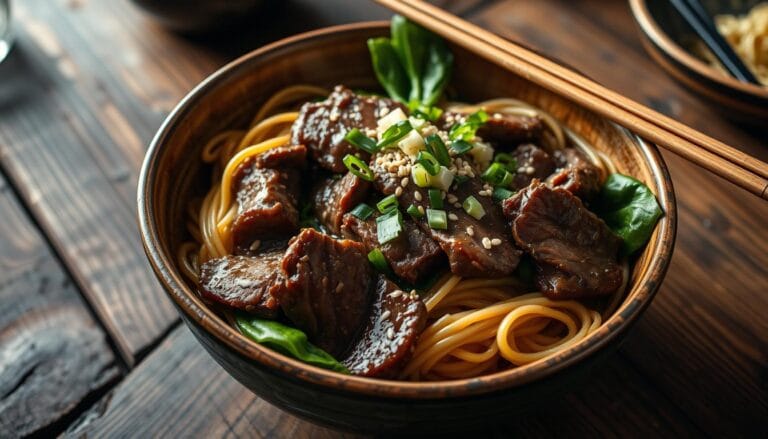Table of Contents
Why Chicken Bone Broth Is a Game-Changer for Your Health
Have you ever wondered why bone broth has become a staple in kitchens around the world? It’s not just another food trend; it’s an ancient elixir packed with nutrients and flavor. Let’s dive into why chicken bone broth should be your go-to comfort food.
Nutritional Benefits of Chicken Bone Broth
Chicken bone broth is like liquid gold for your body. It’s rich in collagen, amino acids, and essential minerals like calcium, magnesium, and potassium. These nutrients support:
- Stronger bones and joints – Collagen helps maintain the integrity of cartilage.
- Healthy skin – It’s nature’s anti-aging serum!
- Improved digestion – The gelatin in broth soothes the gut lining.
How Bone Broth Supports Gut Health and Immunity
Feeling under the weather? Bone broth can help. The gelatin in chicken bone broth aids digestion by binding to water in your digestive tract. Plus, it boosts your immune system with minerals and compounds that reduce inflammation.
Think of it as a cozy blanket for your insides.
Common Mistakes People Make When Preparing Chicken Bone Broth
Making bone broth sounds simple, right? Toss some bones in water and call it a day. But trust me, there are a few pitfalls to avoid if you want that perfect golden liquid.
Mistake #1: Using Low-Quality Ingredients
Not all chicken bones are created equal. Avoid factory-farmed or low-quality chickens. Opt for organic or pasture-raised chicken bones for the best flavor and nutrients.
Mistake #2: Not Cooking Long Enough
A rushed broth is a sad broth. The magic happens when you simmer it for hours (or even days) to extract all the goodness from the bones.
Mistake #3: Skipping the Vinegar
Apple cider vinegar isn’t just for health nuts. Adding a splash helps draw out the minerals from the bones, making your broth more nutritious.
Essential Ingredients for the Perfect Chicken Bone Broth
You don’t need a pantry full of exotic ingredients to make this. Here’s what you’ll need:
| Ingredient | Quantity | Purpose |
|---|---|---|
| Chicken bones | 2-3 pounds | The star of the show |
| Water | 12 cups | Forms the base of the broth |
| Apple cider vinegar | 2 tablespoons | Extracts minerals from the bones |
| Carrots | 2 large | Adds natural sweetness |
| Celery stalks | 2 stalks | Balances the flavor |
| Onion | 1 large | Adds depth |
| Garlic cloves | 3-4 cloves | Boosts flavor and immunity |
| Bay leaves | 2 | Enhances aroma |
| Salt and pepper | To taste | Brings it all together |
Step-by-Step Guide: How to Make the Best Chicken Bone Broth

Ready to create a pot of wholesome deliciousness? Let’s get cooking!
Step 1: Preparing the Ingredients
Start by gathering all your ingredients. Chop the vegetables roughly; no need for perfection here. Place the chicken bones in a large stockpot.
Pro Tip: Roast the bones at 400°F (200°C) for 20 minutes beforehand to deepen the flavor.
Step 2: Cooking on Stovetop, Slow Cooker, or Instant Pot
Stovetop:
- Add the water, vinegar, and vegetables to the pot.
- Bring to a boil, then reduce to a simmer.
- Skim off any foam that rises to the top.
- Simmer for at least 12 hours (up to 24 for maximum flavor).
Slow Cooker:
- Combine all ingredients in the slow cooker.
- Set on low and cook for 12-24 hours.
Instant Pot:
- Place everything in the pot.
- Cook on high pressure for 2 hours, then let it naturally release.
Step 3: Straining and Storing Your Broth
Once cooked, strain the broth using a fine-mesh strainer. Let it cool before transferring it to airtight containers.
Storage Tips:
- Refrigerate for up to 5 days.
- Freeze for up to 6 months (use ice cube trays for easy portions).
Tips and Tricks for Making Your Broth Extra Flavorful
Want to elevate your broth game? Here’s how:
Roasting the Bones for a Deeper Flavor
Roasting your chicken bones before simmering adds a rich, smoky flavor to your broth. It’s like giving your broth a little hug of warmth.
Adding Herbs and Spices to Customize Your Broth
Try tossing in fresh thyme, rosemary, or even a dash of turmeric for added complexity and health benefits.
How to Store and Preserve Chicken Bone Broth
Storing your broth properly is key to making the most of your hard work.
Freezing vs. Refrigerating: What You Need to Know
Refrigeration is great for short-term use, but for longer storage, freezing is your best bet.
Using Ice Cube Trays for Portion Control
Pour broth into ice cube trays for convenient, single-serving portions. Perfect for adding to sauces or sipping on a cold day!
Creative Ways to Use Chicken Bone Broth in Your Cooking
Bone broth isn’t just for soups. Here are some creative ways to incorporate it:
- Soups and stews – It’s a classic for a reason.
- Cooking grains – Swap water for broth to infuse your rice or quinoa with flavor.
- Morning sip – Warm a cup of broth and add a pinch of salt for a cozy drink.
The Most Common Questions About Chicken Bone Broth (FAQs)
How Long Should I Cook Chicken Bone Broth?
The longer, the better. Aim for 12-24 hours for the stovetop or slow cooker, and 2 hours in the Instant Pot.
Can I Reuse the Bones for Another Batch?
Yes, but the second batch will be less flavorful. Add fresh aromatics for a boost.
How Can I Avoid Cloudy Broth?
Simmer gently and avoid stirring too much.
Is Chicken Bone Broth Good for Weight Loss?
Absolutely! It’s low in calories and packed with nutrients, making it a great addition to a weight-loss plan.
What Makes Chicken Bone Broth Taste Better?
Roasting the bones, adding fresh herbs, and using high-quality ingredients make all the difference.
What Should You Not Put in Bone Broth?
Avoid adding starchy vegetables (like potatoes) and overly strong-flavored spices (like curry powder) as they can overpower the broth.
What Is the Downside of Bone Broth?
Some people may find it too high in sodium if not prepared carefully. Also, it’s not a complete source of protein.
What Are the Best Bones to Use for Chicken Bone Broth?
Chicken feet, necks, and wings are collagen-rich and ideal for making a gelatinous broth.
What Spices Are Good in Bone Broth?
Bay leaves, thyme, rosemary, turmeric, and black pepper are excellent choices.
What Should I Add to Chicken Broth to Make It Taste Better?
Add a splash of apple cider vinegar, fresh herbs, or even a squeeze of lemon juice for brightness.
What Happens to Your Body If You Drink Bone Broth Every Day?
Drinking bone broth daily can support joint health, improve digestion, and enhance skin elasticity.
Why Put Apple Cider Vinegar in Bone Broth?
It helps break down the bones and release minerals into the broth, enhancing its nutritional value.
Why Put Carrots in Bone Broth?
Carrots add a natural sweetness and balance the savory flavors of the broth.
Troubleshooting Problems in Chicken Bone Broth Recipes
Why Does My Broth Lack Flavor?
You might not be using enough bones or cooking it long enough. Adjust and try again.
How Can I Fix Overly Salty Broth?
Dilute it with more water or unsalted broth.
What Should I Do If My Broth Doesn’t Gel?
Don’t worry! It’s still nutritious. Next time, add more collagen-rich bones like chicken feet.
Conclusion: Why This Recipe Will Transform Your Cooking and Health
“The best chicken bone broth recipe you’ll ever make” isn’t just a promise; it’s an invitation to experience the magic of homemade broth. From boosting your health to enhancing your meals, this golden liquid is a game-changer. So, grab those bones and get simmering! 🍳
Print
The Best Chicken Bone Broth Recipe You’ll Ever Make
- Total Time: 12–24 hours and 15 minutes
- Yield: Approximately 8 cups 1x
- Diet: Gluten Free
Description
Discover how to make a nutrient-rich chicken bone broth that’s both flavorful and beneficial for your health. This recipe guides you through simple steps to create a comforting broth perfect for sipping or as a base for various dishes.
Ingredients
- 2–3 pounds of chicken bones (preferably organic or pasture-raised)
- 12 cups of water
- 2 tablespoons apple cider vinegar
- 2 large carrots, roughly chopped
- 2 celery stalks, roughly chopped
- 1 large onion, quartered
- 3–4 garlic cloves, smashed
- 2 bay leaves
- Salt and pepper to taste
Instructions
- Prepare the Ingredients: Place the chicken bones in a large stockpot. Add the chopped carrots, celery, onion, and garlic.
- Add Liquid and Vinegar: Pour in 12 cups of water and add 2 tablespoons of apple cider vinegar. Let the mixture sit for about 30 minutes; the vinegar helps extract minerals from the bones.
- Bring to a Boil: Place the pot over medium-high heat and bring the mixture to a boil.
- Skim Foam: As the broth comes to a boil, skim off any foam or impurities that rise to the surface using a spoon.
- Add Bay Leaves and Simmer: Add the bay leaves. Reduce the heat to low, cover, and let the broth simmer gently for at least 12 hours, preferably up to 24 hours. The longer the simmer, the more nutrients and flavor are extracted.
- Strain the Broth: After simmering, remove the pot from heat. Using a fine-mesh strainer or cheesecloth, strain the broth into a large bowl to remove the solids. Discard the bones and vegetables.
- Season and Store: Season the broth with salt and pepper to taste. Let it cool to room temperature, then transfer to airtight containers. Refrigerate for up to 5 days or freeze for up to 6 months.
Notes
- Roasting for Extra Flavor: For a deeper, richer flavor, roast the chicken bones at 400°F (200°C) for about 20 minutes before adding them to the pot.
- Herb Variations: Feel free to add fresh herbs like thyme, rosemary, or parsley during the simmering process for added aroma and taste.
- Gelatinous Broth: A well-made bone broth may become gelatinous when refrigerated due to the collagen extracted from the bones; this is a sign of a good broth.
- Prep Time: 15 minutes
- Cook Time: 12–24 hours
- Category: Soup/Base
- Method: Simmering
- Cuisine: Various
Nutrition
- Serving Size: per 1-cup serving
- Calories: 50 kcal
- Sugar: 1g
- Sodium: 150mg
- Fat: 2g
- Saturated Fat: 0.5g
- Unsaturated Fat: 1.5g
- Trans Fat: 0g
- Carbohydrates: 2g
- Fiber: 0g
- Protein: 6g
- Cholesterol: 15mg







